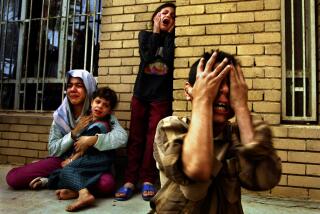Somalia’s deadly lessons
- Share via
REMEMBER Somalia?
On Oct. 3, 1993, 18 U.S. soldiers were killed in a botched raid. An angry Somali mob dragged dead Americans through the streets of Mogadishu. Washington’s reaction was swift. On Oct. 7, President Clinton announced that all U.S. troops would be pulled out of Somalia within six months.
Today, Somalia is in the news once more. Over the past few years, the Bush administration has allegedly been providing covert aid to the Somali warlords we once battled, apparently in the hope that the warlords would assist U.S. counter-terrorism efforts. But many ordinary Somalis resented the warlords’ rule, and on June 6, extremist Islamic militants seized control of Mogadishu, forcing out the warlords. By the end of last week, the Islamists controlled most of southern Somalia.
With Somalia spiraling once more toward disaster, it’s a good time to reevaluate the failed 1993 military intervention.
Although U.S. troops withdrew from Somalia as planned in March 1994, images of dead American soldiers being dragged through Mogadishu’s dusty streets have obsessed political and military thinkers ever since. Some have even given the obsession a label: Somalia Syndrome. Somalia Syndrome causes delusional and dangerous behavior in politicians, but it’s a difficult ailment to understand because it manifests itself differently on different sides of the political spectrum.
For many in the Clinton administration, Somalia Syndrome was initially characterized by a deep conviction that the American public would not tolerate military interventions that endangered American lives. Tragically, Somalia Syndrome led Clinton to resist calls to intervene during the Rwandan genocide and to intervene only reluctantly and belatedly to stop ethnic cleansing in Bosnia and Kosovo.
For the Republicans who came to dominate the Bush administration, Somalia Syndrome was characterized by dramatically different symptoms, including a conviction that the U.S. needed to take what Vice President Dick Cheney termed “decisive and relentless action” against all who threatened the U.S. Only that, Cheney believed, would correct the impression that “our country was soft,” an impression the U.S. withdrawal from Somalia after the Battle of Mogadishu might have created.
Somalia Syndrome was a major factor in Republican enthusiasm for the war in Iraq. The Bush administration concluded that Saddam Hussein needed to be toppled not so much because of the severity of the threat he posed but because doing so would send a message that the U.S. was no longer “soft.”
But, blinded by Somalia Syndrome, both the Clinton and Bush administrations missed the true lessons of Somalia.
Contrary to conservative mythologizing, the Somalia mission was doomed well before Clinton withdrew U.S. troops, and it was doomed by the same factors that are today dooming U.S. efforts in Iraq.
In 1992 -- a presidential election year -- then-President George H. W. Bush sold the Somalia intervention to Americans as a simple, feel-good humanitarian mission. In fact, Somalia had long been in the throes of a complex and deadly civil war when U.S. troops arrived, and when it came to Somali politics, the U.S. had never been a neutral party.
Years of U.S. support for the brutal Somali dictator Mohamed Siad Barre led many Somalis to see the U.S. intervention as partisan -- a problem that was exacerbated when U.S. officials alternated, seemingly arbitrarily, between dealing with warlords as legitimate local leaders and demonizing them. Most U.S. political and military decision-makers lacked even a basic understanding of Somali politics, history, language and culture, and their ignorance caused constant misunderstandings. In the end, U.S. intervention in Somalia arguably increased, rather than decreased, the violence and instability that led to famine in Somalia.
By the beginning of October 1993, the situation had deteriorated far beyond military repair. The Battle of Mogadishu and the subsequent withdrawal of U.S. troops were symptoms of the mission’s failure, not causes. Ultimately, though Clinton was wrong to conclude from Somalia that Americans wouldn’t make sacrifices in foreign lands, his decision to withdraw U.S. troops after the Mogadishu fiasco was little more than a belated recognition of what the U.S. should have known all along.
The true lesson of Somalia is that foreign nations are not blank slates for the U.S. to write upon. In 1993, ignoring our own role in creating the disaster we came to ameliorate, we thought we could solve Somalia’s complex political and social problems by offering food with one hand while we pointed a gun with the other. As recent events suggest, the U.S. continues to dangerously misread Somali politics today.
In Iraq, the Bush administration is repeating the same mistakes, and the signs of failure are becoming ever more frequent and vivid. In Somalia, the symbol of our failure was slain U.S. soldiers dragged through the streets. In Iraq, it’s the mutilated bodies of Thomas L. Tucker and Kristian Menchaca.
More to Read
Sign up for Essential California
The most important California stories and recommendations in your inbox every morning.
You may occasionally receive promotional content from the Los Angeles Times.













